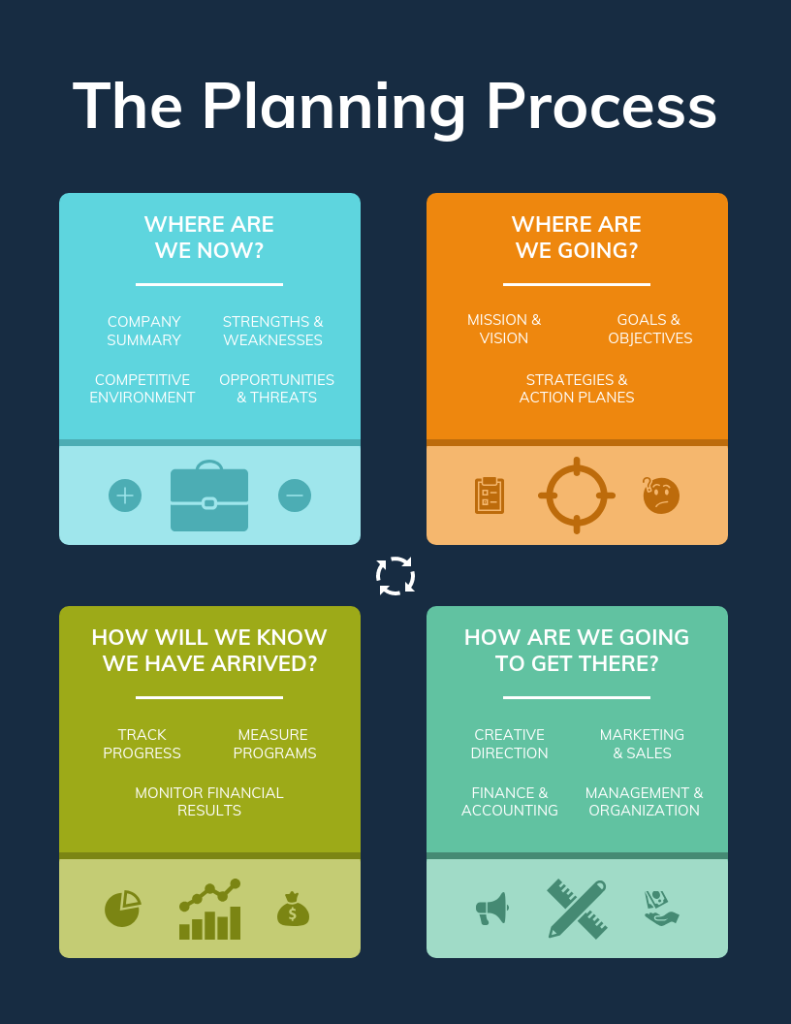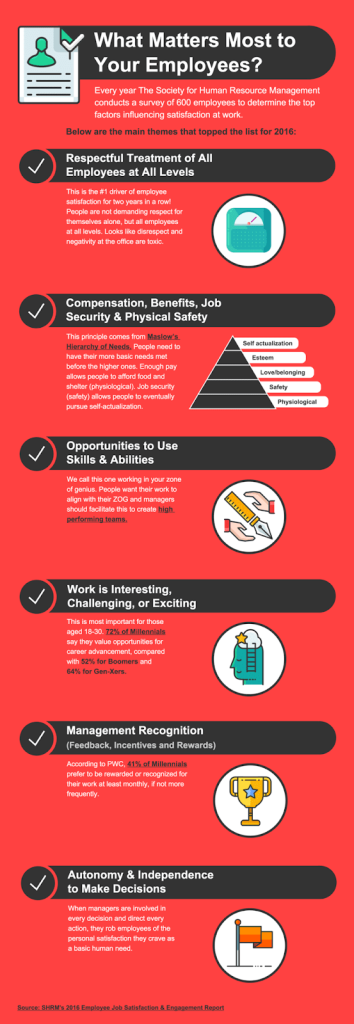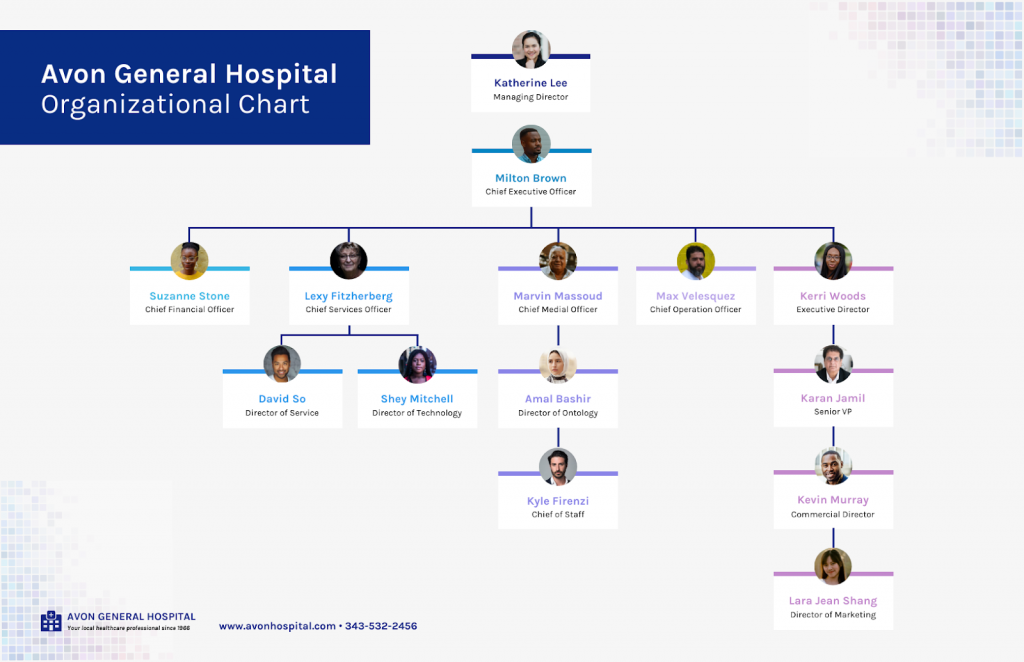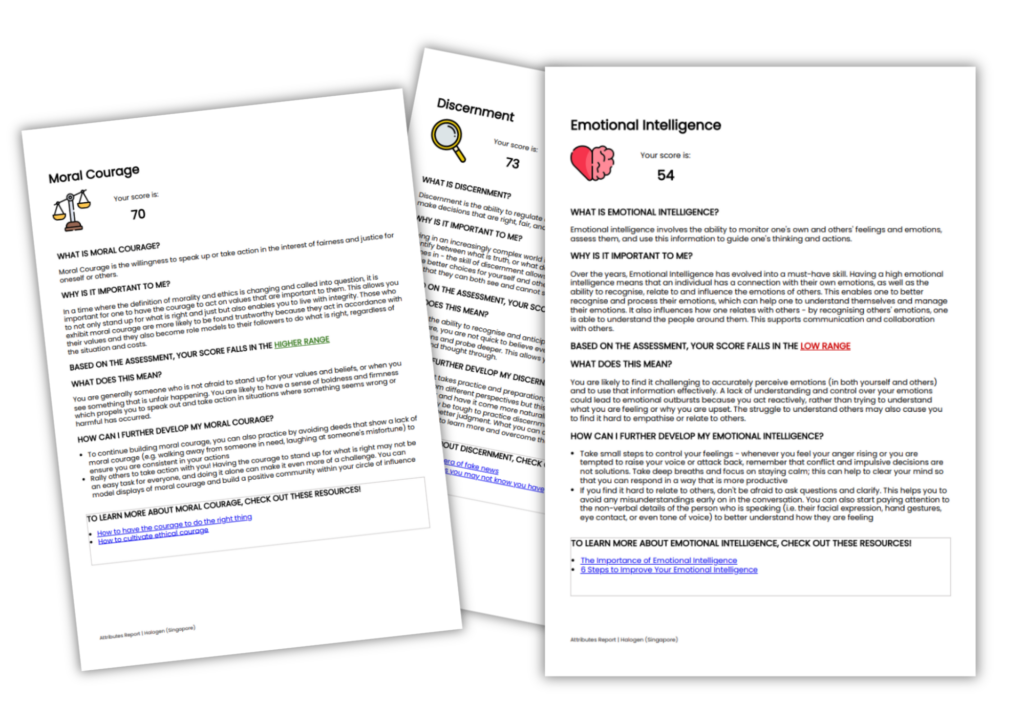Strategic planning needs to be a priority for businesses in 2021—the changing environment has made it more necessary than ever before.
Now is the time to bring in consultants to review what has worked in the past and how to plan for the future.
We look at how to revise strategies when creating a consultant report that will effectively set up companies for a better 2021.
1. Study the team
If a company doesn’t know how its team functions, or what its strengths are, it is impossible to plan for the future.
The first step that consultants will have to take when working on a strategic plan is to study existing teams.
It is worth designing an organizational chart like the example below to visualize the team structure.
Conduct personality tests to assess the temperament of people working in the organization—this will help to mold the environment for more efficient practices.
Look at more than just what the company is asking employees to do.
What are they skilled at and where do their strengths lie? What additional and non-work-related abilities do they possess and could those be beneficial to the company?
But also examine where the employees’ weaknesses are—what tasks do they struggle with? What can be done to help them overcome those barriers?
One may find that additional training or a reworking of roles is in order—some tasks may need to be handled by different teams because they no longer fit the same roles they used to.
2. Incorporate transparency

Transparency is of utmost importance in a work environment—with the changing world we currently live in, it has taken precedence over other areas.
There is no place for secrecy when a company is trying to learn and grow—find out whether the company’s vision and mission statement are clear to employees.
What are the values that they want to uphold and project to their employees and their customers?
Part of the strategic planning process needs to be looking back at the past year to examine the blocks in information flow.
Ask employees whether they felt they had access to those in leadership positions and if their queries and concerns were handled swiftly or put on the backburner.
Is there a setup for two-way team communication? Can those in the lower rungs of the organizational structure share their feedback?
Are only employees expected to accept errors and mistakes, or is there consistency across the board about who owns up to faults that occur?
Some of these questions can be very difficult to answer—but if businesses want to move towards a successful 2021, they need to be transparent about the internal flaws.
3. Build collaborative structures
With remote work becoming the norm, building collaborative structures within an organization has become a central focus of strategic planning initiatives.
There are two sides to collaboration in the workplace—within an office environment and for remote workers.
For companies that are still working out of their office premises—or will be doing so soon—it is imperative that employees be encouraged to work together.
Several businesses believe that competitive environments foster better productivity and results—but this doesn’t work for all employees.
Not everyone wants to compete with their colleagues—additionally, constantly competing with each other can breed resentment and hostility.
When consultants inspect how a company encourages its employees to interact, they will want to see a more collaborative atmosphere where people work together to achieve a common goal. One of the best ways is to use knowledge base software that will allow you to share information and keep your teams engaged.
This attitude heavily influences remote workers or employees who work from home—as they have been doing for the past year.
People working from home can feel isolated and disconnected from their colleagues and the buzz of the workplace—for them, instilling a collaborative attitude will be beneficial.
Instead of trying to outdo each other, employees will find satisfaction in problem-solving together and achieving their directives.
Of course, it is important to avoid collaboration overload so employees can finish their work instead of constantly trying to help each other.
But in general, a collaborative environment will always be more advantageous to companies than one built on competitiveness.
4. Revise company goals
Strategic planning is tied to business goals, which will have changed during 2020—some companies are just trying to stay open, whereas others can afford to grow.
Consultants should talk to upper management about revising the company’s goals and even their vision.
Speak to team leaders and managers for their inputs—they can discuss roadblocks and successes with their teams to establish reasonable goals for the next year.
Conduct a SWOT analysis on the business as well as a comparative analysis with their competitors—where are they lagging in the marketplace, or what gaps are they filling?
The world we live in has changed—businesses need to be circumspect with their expectations for the coming years.
Be attentive to what has and hasn’t worked this year to give the company a fighting chance in the future.
5. Bolster employee engagement

As we have noted, employees are a huge resource for businesses—their strengths can make or break a company.
While understanding their abilities and helping them collaborate can go a long way in boosting the organization, consultants also need to see how well they prioritize employee engagement.
Several questions can be asked to determine this:
- Are the employees committed to the company?
- Do they enjoy working there?
- Are their achievements and successes recognized?
- Do they have a sense of autonomy and independence?
- How do they feel about the goals they are set? Are they achievable?
- Are there learning opportunities in the business?
- Can they achieve their professional goals within the company?
- Would they recommend this business to their circles?
- Are the financial compensations satisfactory?
- Do you need employee scheduling software?
The more positive the answers to these questions, the more engagement the company boasts within its human resources.
Areas that are still lagging need to be flagged in the strategy report for the business to prioritize in 2021.
6. Leadership development
Companies need to have opportunities for organic growth within their ranks. Leaders eventually need to move on, making room for those below them to rise.
But any growth that takes place needs to be earned—bumping someone into a leadership role just because there’s a vacancy could negatively impact the company.
When a consultant examines the growth potential for the company, they will need to see whether employees have opportunities to improve their skills and to become leaders.
What are the training facilities available to them? Do they get to shadow managers and leaders? Are there mentorship programs in place? What resources and support can they access?
It isn’t just about improving working abilities or giving employees more management experience that helps someone become a leader—they also need to improve their interpersonal skills.
Planning for the future means ensuring that at every rung, employees have opportunities to move ahead and are equipped with the resources needed for their advancement.
7. Create feedback channels
We have touched upon how important feedback is in the strategic planning process—but consultants need to determine if there are channels for people to share their thoughts.
An important aspect of determining feedback channels is whether the organization is taking a top-down approach or is allowing feedback from everyone.
Critiques from management and executives can often come across as directives that have to be acted upon.
But that doesn’t make for a healthy environment—a company that silences employees depending on their status isn’t going to grow in the future.
Setting up surveys for employees to share their roadblocks, suggestions, and experiences is necessary, but managers and leaders also need to listen to these and act on them.
What are the expectations of employees, and how are they judging their performance? Is there a standardized reporting format? Is there room for qualified feedback?
If these feedback channels don’t already exist or aren’t functioning optimally, plans for the future need to address this issue and offer solutions.
8. Define metrics
When a company has its goals set for the future, it can start focusing on its KPIs and metrics.
All goals should be SMART—specific, measurable, achievable, relevant, and timely.
The most common metrics for businesses include the following:
- Revenue earned vs business costs
- Quarterly profits
- Sales increases
- Website traffic
- Number of subscriptions
- Social media followers
- Customer satisfaction scores
- Loyalty program registrations
The strategic planning process should compare and contrast the defined metrics from last year with the gains and losses during the first half of this year.
Additionally, consultants should be pushing for management to determine what metrics would be feasible considering the changed situation of the world.
Speaking to team members for their input is imperative—they are on the ground and closer to a project or campaign. This makes them the best people to understand what is too lofty a goal.
Consultants should also ensure that there are systems in place to track these metrics—data should be collected using social analytics, Google analytics, and customer surveys.
Use data visualization to understand the context of the metrics and determine what areas require improvement and which have been most successful.
Conclusion: Make strategic planning a priority in 2021
Strategic planning has taken on a new form due to global conditions, but it is a necessary exercise for determining a company’s course for the future.
Consultants are best positioned to undertake this exercise—as third parties, they can have an impartial understanding of the company and be objective about their options.
By following the eight steps outlined above, consultants will be able to create a strategy report that can drive companies to success.






